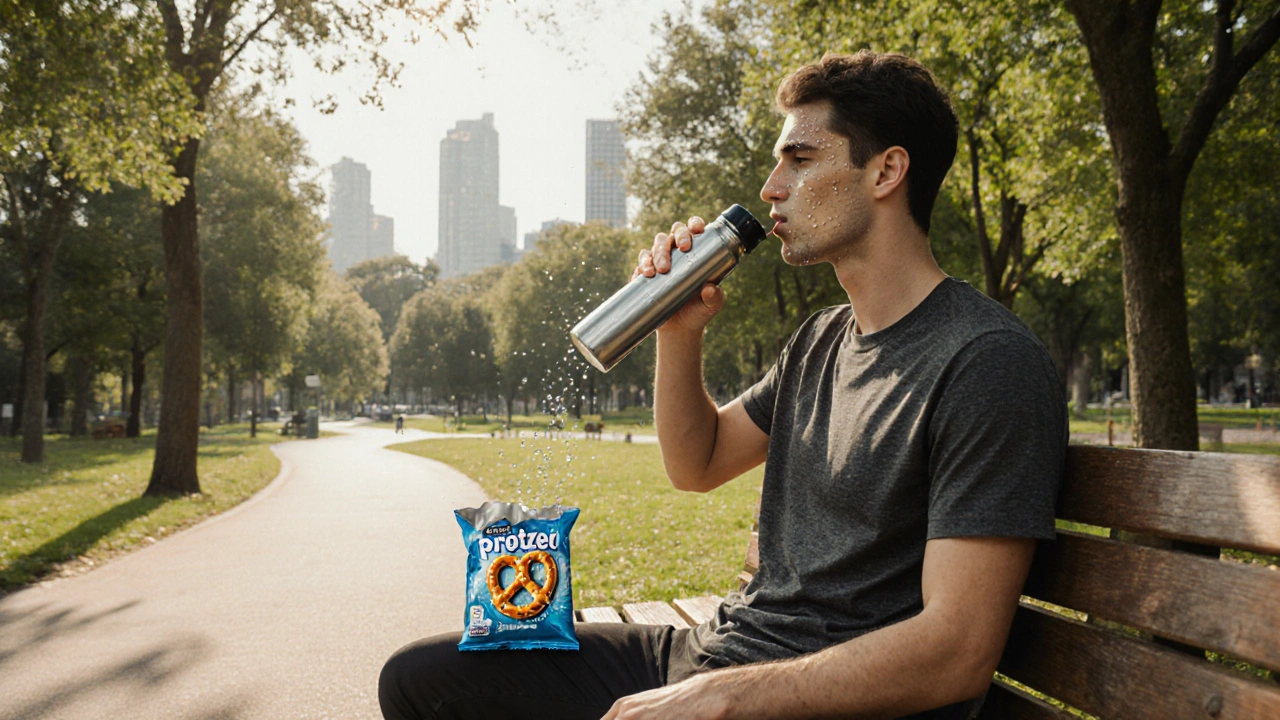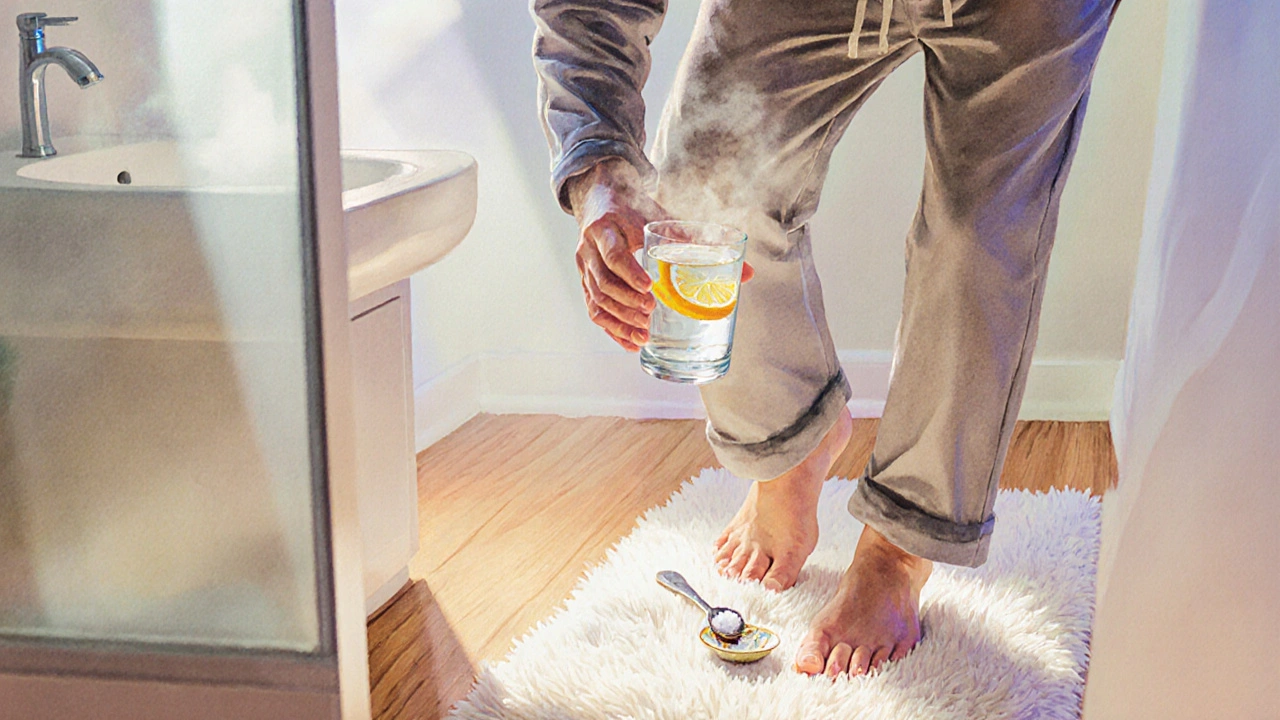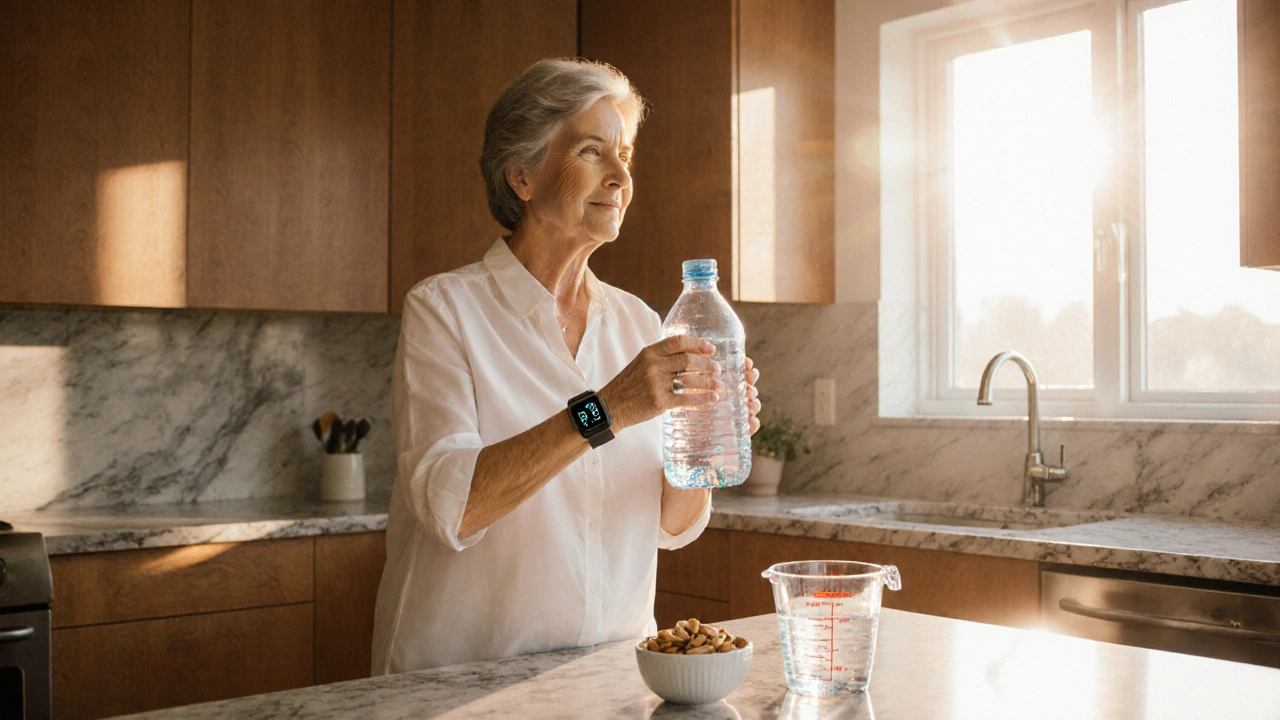Idiopathic Orthostatic Hypotension is a neurological condition where blood pressure drops 20mmHg systolic or 10mmHg diastolic within three minutes of standing, without an identifiable cause. It affects roughly 5% of adults over 60 and often shows up as dizziness, blurred vision, or fainting. Because the brain receives less blood when you rise, the body’s compensatory mechanisms-mainly the autonomic nervous system and baroreflex-struggle to keep perfusion stable.
Why Hydration Matters
Water isn’t just a thirst‑quencher; it’s the primary driver of blood volume. When you’re adequately hydrated, the plasma component of blood stays at optimal levels (≈55% of total blood). A drop of even 5% in plasma volume can cause the orthostatic drop that triggers symptoms. Proper hydration therefore acts like a built‑in pump‑assist, giving the heart and vessels enough fluid to maintain pressure while you transition from sitting to standing.
Choosing the Right Fluids
Not all drinks are created equal for IOH management. Plain water is low‑calorie and easy, but it contains virtually no sodium, which is needed to retain fluid in the vascular space. Oral Rehydration Solutions (ORS) combine glucose and electrolytes, promoting sodium‑linked water absorption in the gut. Salt tablets provide a concentrated sodium boost without extra fluid, useful when fluid overload is a concern.
| Fluid | Sodium (mg per serving) | Typical Volume (ml) | Onset of Effect | Best Use Case |
|---|---|---|---|---|
| Plain Water | 0 | 250‑500 | 30‑45min | General daily intake |
| Oral Rehydration Solution | 250‑300 | 200‑250 | 15‑30min | Fast plasma expansion |
| Salt Tablet (½g) | 500 | - (no added fluid) | 45‑60min | When fluid restriction needed |
For most people with IOH, a combo works best: start the day with a glass of ORS, sip water throughout, and add a modest salt tablet at mid‑morning if you notice a dip in blood pressure.
Sodium Intake - The Hidden Lever
When you consume sodium, the kidneys retain more water, expanding plasma volume. The recommended daily sodium for IOH patients is often 3‑4g (≈130‑170mmol), higher than the general public guideline of 2.3g. Sources include table salt, bouillon cubes, salty cheeses, and sports drinks. However, excess sodium can raise blood pressure in the long term, so balance is key. Tracking intake with a simple app helps you stay within the therapeutic window.
Adjunctive Therapies
Hydration is a cornerstone, but many clinicians pair it with other measures. Compression Stockings (30‑40mmHg) compress the leg veins, reducing blood pooling and improving venous return. They’re especially useful during prolonged standing or in hot climates.
Fludrocortisone is a synthetic mineralocorticoid that prompts the kidneys to keep sodium and water, modestly raising blood volume. Typical doses range from 0.05mg to 0.2mg daily, adjusted based on blood pressure response and electrolyte monitoring.
The Tilt Table Test is a diagnostic tool that reproduces the orthostatic stress in a controlled setting, allowing physicians to quantify the drop and gauge treatment effectiveness.

Putting It All Together - A Daily Hydration Blueprint
- Morning (within 30min of waking): 250ml ORS + 1L plain water.
- Mid‑morning: ½g salt tablet with a small water sip.
- Before lunch: 300ml water; monitor for any dizziness.
- Afternoon: If symptoms appear, repeat ORS dose (200ml).
- Evening: 500ml water; avoid caffeine after 6pm to reduce nocturnal diuresis.
Keep a simple log: time, fluid type, volume, and any symptoms. Over a week, patterns emerge, and you can fine‑tune amounts.
Common Pitfalls & How to Avoid Them
- Over‑hydrating without sodium. Pure water can dilute plasma sodium, paradoxically worsening symptoms. Pair water with salty snacks or a pinch of sea salt.
- Relying solely on coffee. Caffeine is a mild diuretic; it may temporarily raise blood pressure but can lead to fluid loss.
- Skipping meals. Food intake naturally raises blood volume (post‑prandial effect). Regular meals help stabilize pressure.
- Ignoring weather. Hot, humid days increase sweating and sodium loss. Increase ORS and salt tablet dose on such days.
Related Concepts Worth Exploring
Understanding IOH fits into a broader picture of autonomic disorders. Topics that naturally follow include Postural Tachycardia Syndrome (POTS), Neurocardiogenic Syncope, and the role of the Baroreflex in short‑term blood pressure regulation. Readers interested in medication‑free strategies may also look into Physical Counter‑maneuvers such as leg crossing or isometric handgrip.
Next Steps for Readers
If you suspect IOH, start a hydration diary today. Schedule a visit with a cardiologist or neurologist for a Tilt Table Test. Ask about a low‑dose fludrocortisone trial and whether compression stockings are appropriate for your lifestyle. Finally, explore the linked topics above to build a comprehensive management plan.

Frequently Asked Questions
How much water should I drink each day to control IOH?
Most adults with IOH benefit from 2-3L of fluid spread across the day, split between plain water and electrolyte‑rich drinks. Adjust up or down based on weight, activity level, and symptom pattern.
Can I rely on sports drinks instead of ORS?
Sports drinks contain sodium and sugar, so they’re a decent alternative, but many have excess sugars that can cause GI upset. ORS formulas are designed for optimal sodium‑glucose ratios (1g glucose to 0.3g sodium per 100ml) and are generally better tolerated.
Is a high‑salt diet safe for the long term?
For IOH patients, a modest increase (up to 4g per day) is therapeutic and usually safe if blood pressure stays within normal ranges. Regular monitoring of blood pressure and electrolytes is essential. If you have hypertension or kidney disease, discuss any changes with your doctor.
Do compression stockings work for everyone?
They help most people by preventing venous pooling, but effectiveness varies. Proper fit (measured at the ankle and calf) and the right compression grade (30‑40mmHg) are crucial. Some patients find them uncomfortable in hot weather, so seasonal adjustments may be needed.
How quickly can I expect improvement after changing my fluid routine?
Many report reduced dizziness within a few days to a week of consistent hydration and sodium intake. Full stabilization may take 2-4weeks as the body adapts and plasma volume expands.

Comments (17)
Ada Lusardi
September 27, 2025 AT 02:28
Wow, reading about IOH really hit home 😢. I’ve been feeling that dizzy spin every time I stand up for years, and finally seeing a plan that talks about water and salt feels like a lifeline 🌊💧. Thank you for pulling this together – it gives me hope that I can actually manage my days without fearing the next blackout.
Pam Mickelson
September 27, 2025 AT 21:06
Great rundown, and the way you broke down the fluid types is crystal clear. I especially love the table – it makes picking the right drink feel way less intimidating. Keep up the awesome work, and thanks for writing something so accessible!
Joe V
September 28, 2025 AT 16:00
Ah, the classic “just drink more water” solution, how novel. One would think that after decades of medical literature we’d have moved past the simple fix of electrolytes and hydration. Nonetheless, the thoroughness of the protocol does earn a smirk, if not a standing ovation.
Scott Davis
September 29, 2025 AT 10:53
True, but it’s also the most practical.
Calvin Smith
September 30, 2025 AT 05:46
Listen up, folks: if you think sprinkling a pinch of salt is some magical cure, you’re missing the bigger picture. The body’s not a leaky faucet you can just patch with a few electrolytes – it demands a disciplined regimen, especially when the baroreflex is playing hide‑and‑seek. So crank that ORS, strap on those compression stockings, and stop whining about “just standing up.”
Brenda Hampton
October 1, 2025 AT 00:40
Hey Calvin, I hear you! Let’s turn that energy into a plan: start the day with that ORS, keep a water bottle handy, and set reminders to sip – that’s how you beat the dip before it even starts. You’ve got the power to rewrite your mornings, one salty sip at a time.
Lara A.
October 1, 2025 AT 19:33
But…what they aren’t telling you is that the “salty sip” agenda is part of a larger…covert…hydration control scheme orchestrated by big‑pharma!; the truth is hidden behind the bland statistics they push, and only the vigilant can see the strings pulling the sodium levels.
Ashishkumar Jain
October 2, 2025 AT 14:26
From a broader perspective, staying hydrated isn’t just a medical routine; it’s a daily meditation on balance, a reminder that we can influence our own physiological rhythm with intention. Small, mindful actions add up, and that’s empowering.
Gayatri Potdar
October 3, 2025 AT 09:20
Yeah right, as if the “big brother” of health ministries isn’t secretly swapping our ORS with sugar‑laden cheats to keep us hooked. Trust me, they’d rather see us jittery than stable – that’s why they push those caffeine‑filled “sports drinks” like it’s a gift.
Marcella Kennedy
October 4, 2025 AT 04:13
Reading through this comprehensive guide reminded me of the countless evenings I spent curled up with a blanket, clutching a pillow as the room swirled around me every time I tried to get up for the bathroom. It was a frightening sensation, one that made me question whether my body would ever cooperate again, and the simple truth that I needed more than just a quick caffeine jolt was not obvious at first. When my cardiologist finally mentioned the role of plasma volume, it clicked like a light bulb; suddenly the puzzle pieces of dizziness, blurred vision, and those alarming near‑faints started to fit together. I began to track every sip of water, every pinch of salt, and even the times when I skipped a meal, noting how each variable shifted my symptoms. The table you provided is pure gold – seeing the sodium content side by side with onset times helps me plan my morning ritual without guessing. I’ve now adopted the “morning ORS + water + salt tablet” routine, and within a week I noticed a steadier heart rate and far fewer wobbling spells. The compression stockings, once a fashion nightmare, have become my secret armor during long grocery trips, and I no longer feel the crushing heaviness in my legs. Fludrocortisone, which I was skeptical about, turned out to be a gentle nudge for my kidneys to retain more fluid, and the blood pressure charts I keep now show a reassuring upward trend. What truly made a difference, however, was the habit of logging each fluid intake along with any symptom flare – the data revealed patterns I would never have sensed otherwise. On hot summer days, I learned to up my ORS dose, while on cooler evenings a simple glass of water sufficed, illustrating the importance of flexibility. Moreover, I discovered that a balanced diet with modest salty foods – think cheese and broth – reinforced the sodium intake without overloading my palate. It’s also crucial to stay mindful of caffeine after six, as the diuretic effect can undo hours of careful hydration. In essence, this plan turned a chaotic, fear‑driven existence into a manageable routine where I feel in control of my own blood pressure. I can finally enjoy a walk to the park without the looming dread of a sudden blackout, and that freedom is priceless. Thank you for sharing such an actionable and compassionate roadmap; it has genuinely transformed my daily life.
Jamie Hogan
October 4, 2025 AT 23:06
Indeed your account illustrates the practical merit of disciplined volume management.
Ram Dwivedi
October 5, 2025 AT 18:00
👍 Great summary! For anyone starting out, I suggest using a simple spreadsheet: column A for time, B for fluid type, C for volume, D for any symptoms. This visual track makes adjustments crystal clear and keeps you accountable.
pooja shukla
October 6, 2025 AT 12:53
Look, spreadsheets are fine but the real secret is the traditional Indian “namkeen” snack – a handful of salted peanuts gives you the perfect sodium boost without any fancy apps. Trust the ancestors.
Poonam Mali
October 7, 2025 AT 07:46
Now that we’ve dissected the basal fluid dynamics, let’s pivot to the psychophysiological feedback loop – the insidious interplay between autonomic dysregulation and maladaptive coping mechanisms that perpetuates orthostatic collapse. It’s not merely a matter of sipping electrolytes; it’s a systemic cascade that demands a multidisciplinary intervention protocol.
Alan Whittaker
October 8, 2025 AT 02:40
The cascade you describe is precisely what shadow health agencies manipulate to keep patients dependent on proprietary infusion kits – a classic case of engineered chronicity disguised as patient‑centered care.
Michael Waddington
October 8, 2025 AT 21:33
Honestly, the whole “water and salt” hype is just a low‑budget placebo; real improvement comes from biofeedback training and neuro‑modulation, not from guzzling flavored powders.
HAMZA JAAN
October 9, 2025 AT 16:26
While your skepticism is noted, dismissing evidence‑based hydration strategies overlooks the simple physics of plasma expansion that underpins orthostatic stability.